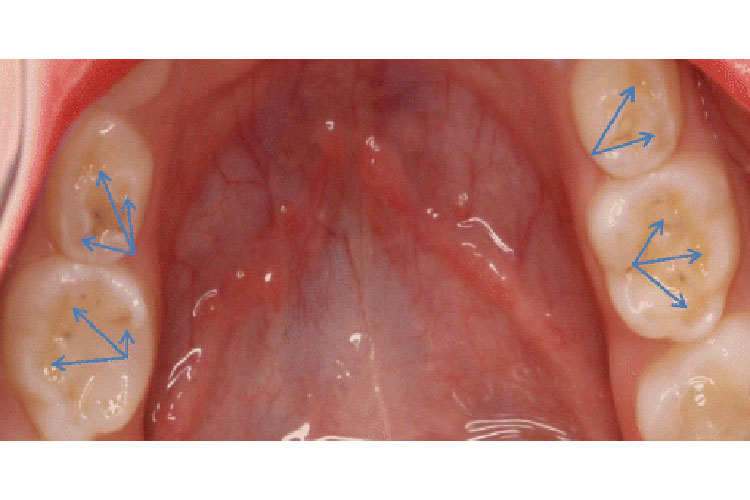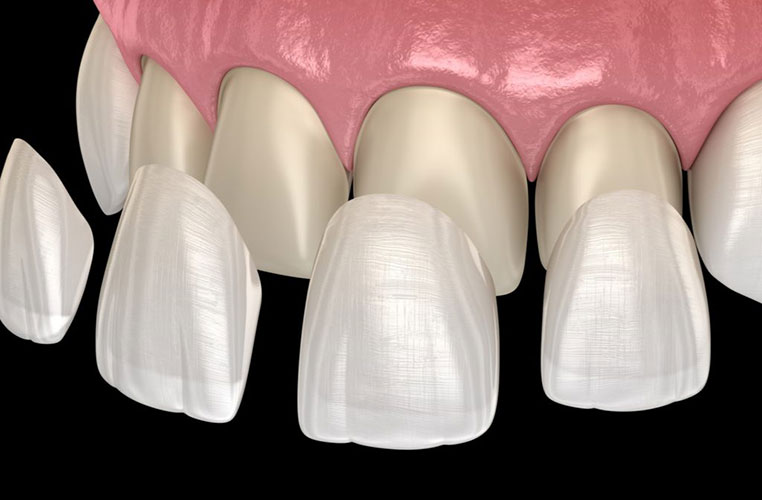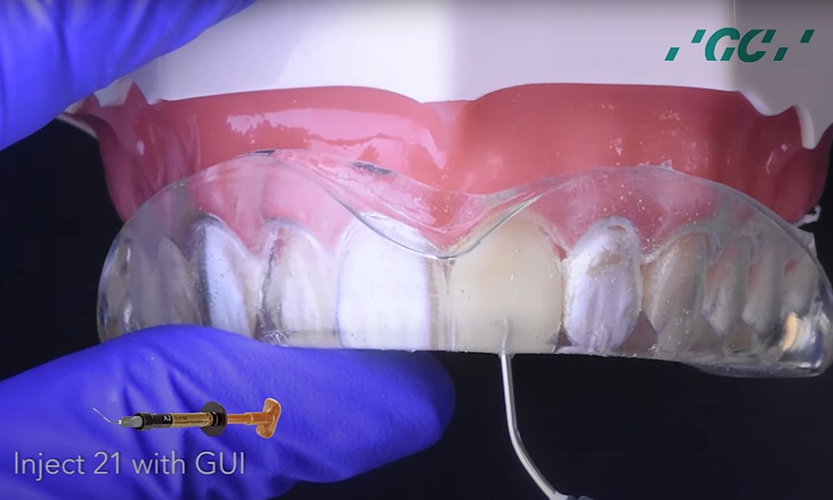Staining, dark pits, and tinted striations on children’s teeth can distract from the otherwise most endearing smile.
If you live in the Mississauga area, St. Lawrence Dentistry can help fix these issues and keep them from happening in the first place.
When parents come to our office and ask what the cause of their children’s teeth staining is, Dr. Hawryluk will first determine if the reason is internal or external. There are several causes of internal staining. If the mother has taken “tetracycline during her pregnancy, the child’s teeth can come out dark. Similarly, using medications containing iron in pregnancy can also stain a child’s teeth. Excessive fluoride (fluorosis) use in children can lead to bright white spots or streaks. Sometimes a soft green shade is observed in teeth in cases where a child had jaundice after birth. Other Illnesses, such as children’s heart disease, correlate with staining.

Please visit us here to learn more about Fluorosis:
What Is Fluorosis And How Do You Deal With It?
While teeth are developing, illnesses can result in a white, yellow, or brown stain – that is most prevalent on the upper central incisors and first molars. When the condition is minimal, it appears as white marks near the biting surface. In more moderate cases, the marks are usually “water variable”, meaning if the tooth desiccates, the area will be more visible. White scars that are bigger and dense will likely need to be removed by Dr. Hawryluk and the blotch area filled with a cosmetic filling material. Yellow or brown spots can often become less noticeable by bleaching.
The revolutionary ICON treatment can rid the teeth of “spots” on your teeth and you can learn more about this treatment here:
If your child endured a high fever for a prolonged time before the age of 10, some disturbance to the permanent dentition might have taken place. When the adult teeth arrive, there may be spots visible on the teeth that were created on the tooth buds at the time of the sickness. The enamel’s tenacity may have been lowered due to the fever, making teeth more prone to dental caries. If Dr. Hawryluk Jr. notices these lines during your child’s dental exam, he may review their cause and go over treatment (if any is indicated).

There are several outside factors (extrinsic) that can stain your child’s teeth. If dental brushing and flossing are not adequate, then a residue of plaque sits on the teeth, which can cause a yellow stain. Of course, our courteous dental hygienists will be happy to review the best pediatric dental home care techniques with your child. If your child has fallen, the upper incisor front teeth can quickly turn pink or grey due to stagnant dried-up blood. Some of these teeth can stay until they naturally fall out around age 8 or 9, whereas others may need removal. Of course, Dr. Hawryluk will figure out the best course of action.

Small black spots can be present anywhere on your child’s teeth, and most of these are harmless. If your child’s teeth are more porous, then staining from food debris will more easily penetrate the tooth. The fissures of molar teeth are the weakest part of the teeth and easily stain black. Some of the fissure stains are benign, but others a sign of “fissure decay” forming and should be closely monitored. One way to help prevent fissure decay is the placement of dental sealants. These are small resins placed into permanent molars’ fissures that siphon off the outside’s dental fissure. Therefore, plaque cannot sit in the aperture, which reduces the risk of dental decay.

Children who swim more than 5 hours a week have a risk of developing swimmer’s teeth. The teeth can stain yellow-brown due to prolonged exposure to acidic chlorine ions. The water pH overwhelms the buffering capacity of saliva, and teeth can break down. One way of helping prevent this is to have your pool serviced by a certified professional who will ensure your pool pH has the ideal pH levels of 7.2 and 7.8. Also, talk to your pool maintenance crew about having non-chlorine-based solutions to keep your pool free of bacteria and algae. If you suspect dental breakdown is happening due to your pool chemistry, please contact St. Lawrence Dentistry, and we will take steps to remineralize your child’s teeth if necessary.

Many parent(s) explain that their child is self-conscious about their teeth and ask about teeth lightening. In many cases, the teeth are an average shade but seem darker to the child and parent(s) simply because the permanent teeth are almost always not as white as the primary teeth, which just fell out. St. Lawrence Dentistry does not recommend tooth bleaching under the age of 18. Studies have shown that about half of children using lighting products end up with some form of gum damage or tooth sensitivity. Tooth whitening, in conjunction with a bleaching light, can cause damage to the tooth pulp in children. Also, whitening too early can set a child up for a habit of chronic prolonged whitening, which can turn teeth slightly grey and lackluster. One mild way to start gentle whitening at a younger age is to brush your teeth for 30 seconds with Crest 3D whitening mouthwash. You close your mouth around your brush and gently burnish it in. We recommend professional monitoring of this mild whitening program. Dr. Hawryluk finds this method will slowly whitening teeth, especially in younger people. If whitening starts around 18 years old, we will very carefully plan out the process. We will select the appropriate bleaching strength for your adolescent child and monitor the process from start to finish. If we find the whitening products are causing tooth sensitivity, we may incorporate other products such as “soothe gel” or “MI paste” to alleviate the discomfort.

To learn more about Tooth Whitening, please visit us here:
Professional Teeth Whitening
Some children have peg laterals, which are upper front “lateral” teeth that are smaller than average. From a functional standpoint, they are acceptable to leave as is. However, if the child and parent(s) want a fuller look, Dr. Hawryluk can do dental bonding, which is the addition of aesthetic tooth material (composite resin) to the tooth surface. Bonding is an ideal solution to peg laterals and many other situations because there is no drilling on tooth structure in the process. A critical detail of peg-lateral treatment is that, if you considering orthodontic treatment for your child, the bonding should occur before the orthodontics. Otherwise, the orthodontist may push all your child’s teeth together, leaving no space for bonding; hence the teeth would have to remain a “peg shape”. Dr. Hawryluk can coordinate any treatment with your child’s orthodontist to ensure the best result. If you need a recommendation for a great orthodontist in the Mississauga area, please let us know.

To learn more about Dental Bonding, please visit us here:
Dental Bonding
Some parents will ask our office if it’s possible to “sand down bumps” on the biting surface of their child’s teeth. Permanent teeth that have just surfaced often have little peaks and valleys on the biting edges called mamelons. These are normal tooth anatomy, and their formation results from bits of enamel fusing as the tooth develops under the gum. The mamelons help the teeth pierce through the gum as it erupts. They can also help your child incise food before chewing. Usually, they will wear away on their own. Generally, we do not recommend shaving down the mamelons until your child is over 15 (if requested by parents).

It is quite common for parents to ask if their child’s gums can be contoured since they feel their child’s smile shows too much “gum” and not enough tooth. Some children indeed have more gum tissue than others, giving them the appearance of a gummy smile.
Other children’s gums are more slanted and angular instead of a more esthetic “scalloped” appearance. There is usually no need to worry as children naturally have a bountiful amount of gum tissue in which the excess starts to recede at puberty. The biologically normal lowering of the gum at this time is called passive eruption. However, in 10% of people, this process does not happen, and it stays covering some of the tooth crowns. Considering this, St. Lawrence Dentistry suggests in most situations to wait on any gum contouring until after age 16. Dr. Hawryluk can do any contouring (also called gingivectomy) with minimal discomfort by the Ellman Automatic Dentosurg unit, precisely and gently cuts and coagulates simultaneously.

We hope this article on teeth appearance and dental treatments for children has been informative. If you have any further questions about this subject and live in the Mississauga area, please give us a call.
Reference Your Childs Teeth, Weidman
- Understanding Dental Cupping on Molars: Causes, Prevention, and Treatment - August 14, 2024
- Bone Preservation: Essential for Strong Dental Implants - August 5, 2024
- Porcelain Veneers from Design to Finish - July 27, 2024










